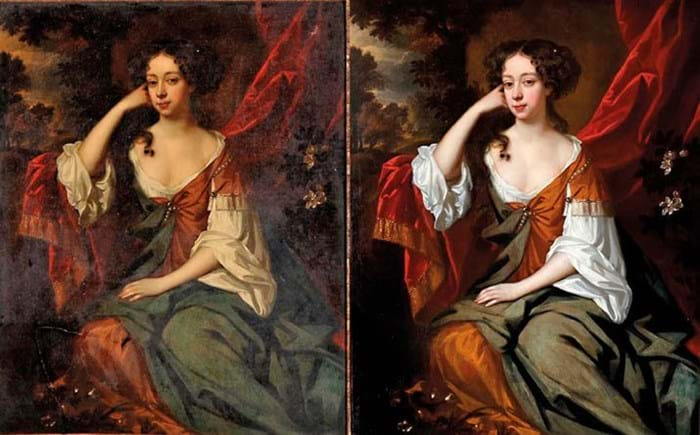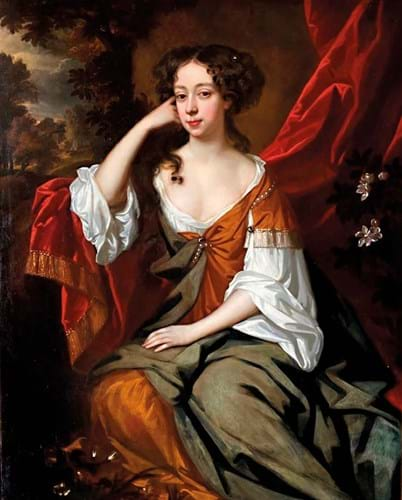The portrait, 4ft x 3ft 4in (1.23 x 1m), depicts the sitter dressed in a green cloak, seated against a dark curtain with a landscape and country house in the background. It went under the hammer in September 2020 at Cabral Moncada Leilões in Lisbon, where it was catalogued as ‘probably’ Wissing and the sitter said to be Mary of Modena, Queen Consort of England.
Claudia Akkermans of Arte-Fact Fine Art spotted it in an auction and, convinced it was something special, managed to acquire it with a bid of €17,000 (£15,000) over a high estimate of €9000.
Then began the long process of discovering who it depicts.

The Willem Wissing portrait before and after cleaning revealed essential details. It is now for sale at Arte-Fact priced €35,000.
First, during a 10-month restoration process, which stretched to over a year with transportation time, a dirty layer of varnish was removed, revealing Wissing’s brushwork and, crucially, his previously partly obscured signature to the lower right.
Research opportunity
Next came the wait for libraries to reopen as coronavirus restrictions loosened.
Research by art historian Adam Busiakiewicz – concluded in December last year – identified the sitter as Lady Mary Bertie (1655-1709), Countess of Carnarvon, second wife of Charles Dormer, 2nd Earl of Carnarvon. It is likely the portrait was produced around the time of their marriage.
Dormer had been a patron of court painter Sir Peter Lely, whom Wissing studied under after moving to England in 1676. After his master’s death, Wissing emerged as his most important student, making him a natural choice for Dormer when commissioning an image of his new wife.
At least two other versions of the portrait have appeared on the open market. One, a studio repetition of the painting catalogued as ‘Circle of Wissing’ and incorrectly identified, sold at Sotheby’s London in 1997. Another, a simplified derivation inscribed with the sitter’s name and title, was sold at Bonhams in 2011.
Akkermans said: “Despite its very yellowed varnish layer, from the very first glance the painting felt mesmerising. My first thought when I saw it in the catalogue was ‘what a beauty’ and my second ‘I’ll never be able to acquire that’. But I still signed up for a telephone line and in the end was able to secure the painting.”
She adds: “Only after the cleaning it was possible to read the painting again and to see both the signature as well as Wissing’s beautiful brushwork.” It is now offered for €35,000.















